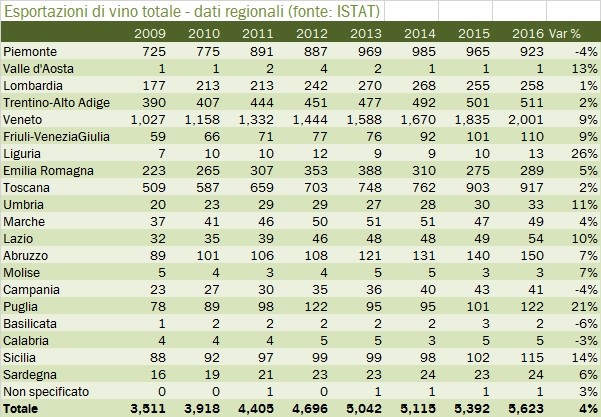The wine from Teramo abroad, the opportunities of the renewed interest in the native vineyards in the world
2017 was a record year for Italian wines in the world. Our country conquered the highest step of the podium among wine exporting countries, traditionally disputed by France and Spain. In 2017 Italy won thanks to a +7% increase in export (for a total value of 6 billion euros, source Coldiretti).
If this trend will be constant also for next year, it could lead to an upward revision of prices for the most renowned wines, due to a relatively poor harvest (-26%) in terms of hectoliters produced.
Certified wines in Italy
Of the estimated 40 milion hectoliters, about 70% will be wines with DOC (332 wines), DOCG (73wines) or IGT (118 wines) certifications. Numbers that allow us to appreciate the fruitful dialogue between the high demand for quality wines and ability of producers to exploit the opportunity offered by the various regulations in terms of guarantee to the consumer.
Also according to Coldiretti, the consumption of certified wines is also increasing on the tables of Italian consumers. This is an important evidence attesting that good wine is not just a gem for restaurant tables but also a faithful companion to home cooking.
The export of Italian wines: constant growth and the gap between the top and the other regions

export vini per regione 2016
Certified wines are equally appreciated in Italy and abroad. In addition to the outstanding increase in export to Russia (+47%) and China (+25%), the increase to countries that traditionally consume more wine is also very significant: USA (+6%), Germany (+3%) and United Kingdom (+8%). This growth has been recorded for many years now and in almost all Italian regions (see the table with ISTAT data on wine export in 2016).
In terms of absolute values, however, the gap between the main regions (Veneto, Toscana, Piemonte and Trentino Alto Adige) and the others is net. Of the 5,6 billion euros exported, the first four regions alone counted about 4,5 billion euros in 2016. Abruzzo, as the other Italian regions with a long tradition of winemaking, shows a steady increase but is still very distant.
It is also true that the new wine trends see the diffusion of a culture of drinking based on the discovery of the native wines of the various Italian regions (source Slawka G. Scarso, Marketing del Vino, chapter 1). In order to verify the existence of an actual interest in Italian regional wines, we did a simple test using Google Trends. For those who don’t konw it, this tool allows you to compare different keywords in terms of research volume on Google in a certain country and time lapse (in percentage and not in absolute values). We tried to compare the “Italian region + wine” combination in the US market between the main regions and Abruzzo.
The result reflects the trends in exports, but it is also a sign that a high interest in Abruzzo wines actually exists. For producers, but also and above all for retailers, this new sensitivity is certainly an opportunity to expand the offer of wines and allow the consumer to appreciate the many faces of italian winemaking scene.
How to spread Italian wine in the world?
As Consorzio Colline Teramane, one of our goals is undoubtedly to promote the knowledge of the wines from Teramo in the world, by investigating the most effective tools and strategies.
One way is certainly the one indicated by Michele Scannavini, president of Ice, during the press conference to present the 52nd Vinitaly: art and wine. Linking wine to the local art works is a fundamental process to communicate abroad the idea of a lifestyle where good wines are a perfect match, both on the table at home ad at the restaurant or bar.
Another tool is offered by new technologies applied to wine marketing. The first attempts to apply the Blockchain technology to wine have aroused a great interest. A tool that allows the consumer to “enter” the wine acquiring certified information about its production and its territory of origin.
In your opinion, are these the right paths to follow to make wine known as a product of the land where it is cultivated? And how? Are there any others?
Whether you are producers, retailers, restaurant owners or passionate consumers, we invite you to leave a comment, in the hope of opening a fruitful dialogue.
![]()


I am thrilled to find a wine from Teramo, the area where i miei nonni came from. I love Montepulciano d’Abruzzo and drink it whenever I find it here in California. I hope to visit Abruzzo on my next trip to Italia and taste it there.